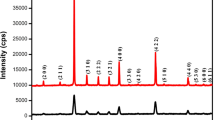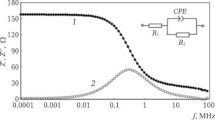Abstract
A study was mode of the dielectric characteristics of γ-AlON and ceramics containing a certain amount of AlON. It was found that ceramics which contain γ-AlON and have an impurity content below 8 vol. % have more stable dielectric properties.
Similar content being viewed by others
References
A. N. Kondrashev, “Production of corundum-based materials with low porosity and high thermal stability by using additions of ZrO2, Si3N4, AlN, and SiO2,”Poroshk. Metall., Nos. 3–4, 48–52 (1998).
P. K. Mehrortra and D. P. Ahyja, “Property optimization of Al2O3 double reinforced with ZrO2 and SiC whisker,”Ceram. Eng. Sci. Proc.,13, No. 9, 688–695 (1992).
K. Komeya, “Effect of various additives on sintering of AlN,”Yogyo Kyokai Shi,89, No. 6, 330–336 (1981).
Thomas B. Troczynski and Patrick S. Nicholson, “Effect of additives on pressureless sintering of aluminum nitride between 1500 and 1800°C,”J. Am. Ceram. Soc.,72, No. 8, 1488–1491 (1989).
M. Zulfequare, D. B. Singh, and A. Kumar, “Effect of moisture on the dielectric behavior of hot-pressed AiN ceramic,”Mat. Sci. Eng. A,102, 131–136 (1988).
G. Long and L. M. Foster, “Crystal phases in the system Al2O3−AIN,”J. Am. Ceram. Soc.,44, No. 3, 255–258 (1961).
H. X. Willems, P. F. Van Hal, G. De Witt, and R. Metselaar, “Mechanical properties of γ-aluminum oxynitride,”J. Mater. Sci., No. 28, 6185–6189 (1993).
D. Lepkova, A. Yoleva, and B. Surney, “Insulation AION ceramics,”Interceram,45, No. 2, 87–97 (1996).
G. T. Adylov and A. A. Maksudov, “Production and properties of γ-aluminum oxynitride,” in:Refractory Nitrides and Materials Based on Them [in Russian], Inst. Probl. Materials Sci. Ukraine Nat. Akad. Sci., Kiev (1992), pp. 34–37.
D. M. Kazarnovskii and B. M. Tareev,Testing of Electrical Insulation Materials [in Russian], Énergiya, Leningrad (1969).
F. G. Zhdan and V. B. Sandomirskii, “Determination of the parameters of traps by the thermally stimulated discharge of a capacitor,”Fiz. Tekh. Poluprovodn,2, No. 1, 11–18 (1986).
Yu. M. Poplavko,Physics of Dielectrics [in Russian], Vishcha Shk., Kiev (1980).
P. V. Kovtunenko, “Physical chemistry of solids,” in:Crystals with Defects [in Russian], Vyssh. Shk., Moscow (1993).
Additional information
Institute for Problems of Materials Science, Ukraine National Academy of Sciences, Kiev. Translated from Poroshkovaya Metallurgiya, Nos. 7–8(408), pp. 8–12, July–August, 1999.
Rights and permissions
About this article
Cite this article
Boitsov, O.F., Petrovskii, V.Y. Electrophysical properties of aion-containing ceramics. Powder Metall Met Ceram 38, 331–335 (1999). https://doi.org/10.1007/BF02676164
Issue Date:
DOI: https://doi.org/10.1007/BF02676164




